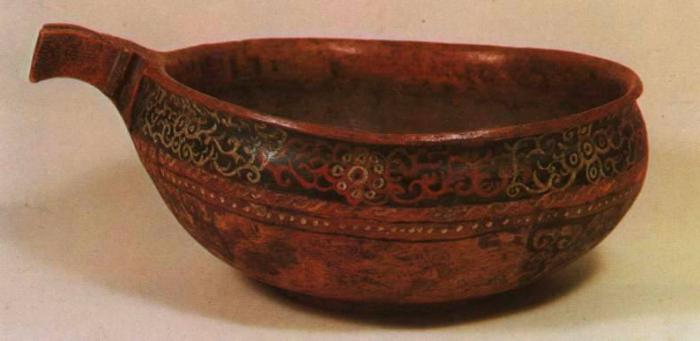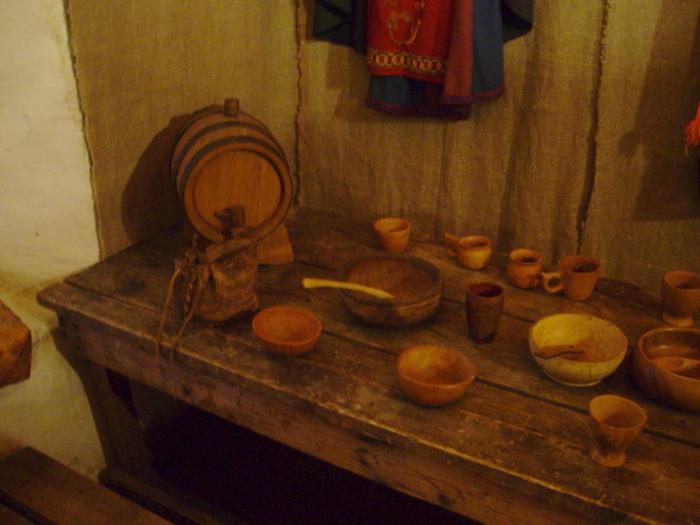Old Russian dishes differed in variety, despite the fact that it was created most often from wood. Its appeal to modern people is that it is beautiful, unusual, and making dishes was a real creative process, a true art, in which the imagination of Russian craftsmen was manifested.
Features of ancient utensils
As already mentioned, in Russia all the dishes were cut out of wood, both for food and for drinking. That is why very few examples of true folk art have come down to us. Old Russian dishes differ in variety - these are bowls, and buckets, and jugs, and carved spoons. These attributes were created in different centers of the Russian principality, and each master was distinguished by his own unique style. Paintings and carvings are the most common decorations of ancient utensils. Today, these products can only be found in museums and in private collections of lovers of ancient gizmos.
What material was used
Not all types of wood were suitable for creating dishes. Most often used birch, aspen, conifers. Soft linden was used to create spoons and ladles. Moreover, the documentation contains old Russian dishes, the names of which attract attention with their unusualness. For example, a spoon is straight, a root bucket - such names do not tell us anything, modern people who are used to glass and porcelain for table setting. In fact, straightness is the wood of the trunk, and the root vessel is a vessel made of powerful rhizomes. Peasants, as a rule, used any tree to create dishes - and ruins, and bark, and flexible roots that are convenient to weave. And the most expensive was considered utensils made from burl - growth on a tree.
Ladle
This ancient Russian dishes came to us in a modified form, because modern models are by no means created from wood. Metal ladles in modern Russia are often used in villages for bath equipment. In ancient Russia, the ladle was considered the most common type of celebratory pottery for drinking - they served honey, kvass, beer. The ensemble of large and small buckets served as a real decoration of the table.

This Old Russian tableware for wine has always been elegant and interesting, for example, in the form of a boat, a floating bird. On the Northern Dvina, they created this dish with two handles that resembled the head and tail of a duck. An important role was also played by the vivid painting that adorned these simple peasant attributes of life. In the Tver province, local craftsmen created vessels in the form of a horse's head, decorated with carvings and a geometric outlet in the center, which is an ancient symbol of the sun. And in 1558, during the reign of Ivan the Terrible, on his orders a ladle was created, decorated with three large sapphires. Today this work of art is stored in one of the museums in Germany, where he got during the Great Patriotic War.
Buckets from different regions
Moscow masters created buckets from the burl, which allowed to preserve a beautiful pattern of the texture. These items had the shape of a boat, a flat bottom, a pointed nose and a short horizontal handle. The vessels had dense and durable walls, and a silver frame was used as additional decor. Kozmodemyansk ladles were created from linden and resembled Moscow in shape, but were deeper and larger in volume. Buckets made by Tver craftsmen were hollowed out from the roots of trees most often in the form of an elongated boat. And in the northern regions skopkari buckets were created - vessels in the form of a boat with two handles, one of which was necessarily made in the form of the head of a bird or horse.
Bread and salt marsh
This ancient Russian dishes was also a mandatory attribute on any table, because bread and salt were important components of the diet. A bread box was used to store flour products, and they made it from the bast - a layer of the tree trunk, which is located between the bark and the core. Such dishes reliably protect bread from mold and moisture.
Salt in Russia was an expensive pleasure, therefore, the creation of utensils for its storage was approached very carefully. The saltwort was made in two basic forms - in the form of a stool with a raised seat-cover, or in the form of a floating bird. Old Russian dishes looked very beautiful and unusual - the pictures show how much attention was paid to the elements of painting and carving.
Brother, cups and eyelids
If the names “bucket” and “salt shaker” (though we often call it “salt shaker”) are familiar to everyone, then the word “brother” is much more complicated. Most likely, the name of this dish comes from the word "brother", which meant a festive feast. As a rule, it was made in the form of a ball, which was intercepted from above by a neck-crown with bent edges. The old Russian ornament on the dishes of this kind was very different. For example, a brother, made in the XVIII century, decorated with paintings in the form of scales with an inscription, has survived to this day. By the way, the inscriptions also played a big role in the design of ancient dishes. They could tell a lot: about the place and date of creation of the attribute, about its owner and so on.
In the old days, dishes were also used, which were wide dishes with low edges. They served fried and baked dishes, and in the monasteries even baked loaves. Veko was an oblong dish that was covered with a lid on top and was additionally equipped with handles. It was used for various purposes: for baking pies, storing kvass, cooking meat dishes. Subsequently, this dish turned into a pan known to us.
Endova and cups
If everything is clear with the cups, then the endova is an old Russian dish, the names of which were different: the bowl, and yandova, and brother. This glassware is a round vessel made of copper or bast, which was used to drink beer, honey, and mash. Such vessels in the form of figures of a duck, a goose, a rooster, and a boat were stylized and each region had its own drawings. Until now, such utensils have been preserved by the Karelians - they create valleys from linden, oak, maple or birch wood.
Tver masters created the best endows from a mouth guard (growth on a tree). The dishes were made in the form of a bowl on a special tray (oval or square) and supplemented with a spout-drain. The vessels were processed with an ax, then leveled with a braid.
Rates and spoons
Old Russian dishes made of wood are unusual and very colorful, and its names are sometimes very unexpected. For example, a stake was used for food, which was created by grinding on a special machine. This dish was two deep bowls - one served as a lid, but it could also be used as a plate. Well, and what kind of holiday table can do without spoons? Probably, many people have this element of utensils - a beautiful and thick wooden spoon, richly decorated with paintings. In the stavs in Russia, fruits and vegetables were also served. But there was also dishes for a specific type of fruit - lemongrass, vegetable, borage.
A large number of types of wooden spoons were in Novgorod the Great. Particularly beautiful looked products that had a raised stalk. Most often, a wickerwork was used as an ornament, which was performed using contour carving technique. And in the northern regions shad spoons were created with inlaid bones or fangs. In addition, in each region, the spoons had their own unique shape. For example, in the Gorky region they created ladles, salad, fishing, thin spoons, which were distinguished by a rounded and faceted handle-handle. Kirov's spoon was distinguished by an egg-shaped scoop and a flat handle.
Drinking vessels
In Ancient Russia, all the dishes used for drinking were called drinking or drinking. Moreover, the name of almost every one of them is interesting and original in terms of origin. Perhaps the simplest and most understandable vessel is a jug - drinks were stored in it and served on the table. A kind of jug was a kumgan, borrowed from its eastern neighbors, distinguished by a narrow neck, a long nose and a handle. In kumgans, water was most often stored, so they were of large volume. Pewter is also a kind of jug. Different drinks were stored and served in the table. But with glass products in Russia, the situation was very interesting. So, already in the XII century the word "glass" was known, but they were brought from other countries.

Glass utensils and Old Russian wooden dishes look very interesting. Pictures from chronicles and ancient records show that most of these attributes were simple, concise, and differed only in drawings and ornaments. Cookware was called by the appearance or material that was used to create it.